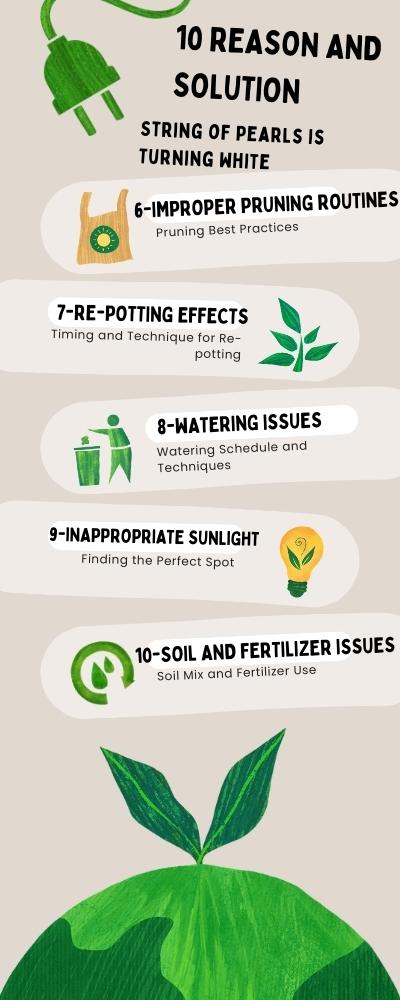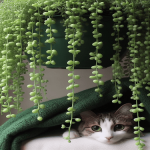Introduction: Unraveling the Mystery Behind Your String of Pearls Turning White
The String of Pearls has cascading vines of spherical, pea-like leaves. It is also known by its scientific name: Senecio Rowleyanus. It resembles a beaded necklace which has brought it an admirable and unique appearance. It is without a doubt a captivating sight in any plant enthusiast’s collection. Additionally, it is also relatively easy to care for. Albeit, let’s not ignore that even the most seasoned plant lovers might see this unfortunate sight: the once lively green pearls begin to fade into a pale, ghostly white. It is imperative to understand why this happens, making it a crucial step in restoring the plant to its former might and beauty.
Although it might not look like anything too serious, it is an SOS. Your String of Pearls turning white is like a baby crying; it is a signal that “I need attention.” This change of color can be attributed to various factors, with each having roots in a different issue which might stem from your caring for the plant or the environment. Take it as a symptom. A symptom that should not be ignored, as it can cause further health problems or even cost the plant its life.
The reasons vary from environmental factors, such as changes in lighting and temperature, to biological threats like pests and diseases. There are various solutions, each suitable for a different issue, but an accurate diagnosis always comes first.
Take this for an example: if sunburn is causing the white color, adjusting the plant’s exposure to light is your plant’s savior. However, if pests are the source of the problem, a different approach to pest control measures is advised.
A string of Pearls turning white commonly happens due to direct sunlight. Although they enjoy sunlight, but too much sun can burn and scorch their delicate leaves. As a result, it can cause a bleached appearance. Moving the plant from a dimmer environment to a sunnier one without the needed attention and caring is most of the time the reason. Having been overwhelmed by the intense offensive of sunlight, the pearls lose their lush green color.
Let’s not forget about another common cause: pest infection. Sap-sucking insects such as mealybugs can drain the plant dry of vitality. The result would be a white, cotton-like residue as the aftermath of their feast. As a result of this feast, the foliage is discolored and the overall health of the succulent is weakened. It will, in due time, cause it to become more susceptible to other stresses and diseases.

Proper watering also plays a critical role in the health of a String of Pearls. Both overwatering and underwatering can lead your String of Pearls to turn white. In particular, overwatering can cause the root to rot. A rotten root hinders the plant’s ability to absorb nutrients, ultimately leading to a pale complexion. Needless to say, depletion of the moisture in the leaves is a result of underwatering, which can cause the same symptoms in addition to shriveling of the plant.
White Mold, a common fungal disease, can also be the reason why your String of Pearls is turning white. Poor air circulation and excess moisture, usually caused by overwatering or high humidity, are the conditions where these diseases thrive. As a result of their activity, the leaves are covered with a powdery white substance, which can eventually kill the plant if not cared for.
Both fertilization and over-fertilization can cause nutrient imbalances, which in turn can be why your String of Pearls is turning white. It is essential to observe the delicate balance of nutrients for the String of Pearls, so it can maintain its beauty and vigor. An excess of certain nutrients, like salt from hard water, can accumulate in the soil and result in a white crust forming on the leaves.
It is important to understand these potential issues as the first step in preventing a String of Pearls from turning white. Careful observation, in addition to a responsive care routine, opens up the possibility to pinpoint the exact cause. It is then possible to take corrective measures. In the following sections, we’ll consider these causes in more detail, while also providing you with practical solutions to make sure your String of Pearls stays a healthy and lively part of your indoor garden.

Reason 1: Pest Infestations
Solution: Pest Control Methods
Mealybugs, as mentioned earlier, can cause serious problems for your String of Pearls, leaving behind white, cottony substances in its wake. To fight off these invaders, pruning affected areas and using insecticidal sprays are effective methods. Make sure to regularly inspect your String of Pearls as it helps in preventing infestations from taking hold.
Reason 2: Direct Sunlight Exposure
Solution: Adjusting Light Conditions
It’s true that these succulents love bright and indirect light, but direct sunlight can burn their leaves and leave them with white discoloration. Use sheer curtains as shielding or position them in a spot with diffused light to maintain protection and to prevent your String of Pearls from turning white.
Reason 4: Over-fertilization
Solution: Proper Fertilization Techniques
Too much of anything, including over-fertilization, can harm your plant’s nutrition diet. To solve the issue, you can, for instance, flush the soil to get rid of excess salts and fertilize sparingly. This is particularly useful during the growing seasons of spring and summer.
Reason 5: Chlorine and Fluoride in Water
Solution: Water Quality Improvement
Chlorine and fluoride are two of the most common residents of tap water. These two minerals can build up and cause white spots in your plant. Using distilled, filtered, or rainwater to prevent these mineral deposits from causing trouble.

Reason 6: Improper Pruning Routines
Solution: Pruning Best Practices
A critical step in ensuring your String of Pearls remains in good health is pruning. Constant pruning with sharp and sterilized scissors will encourage growth and act as disease prevention.
Reason 7: Re-Potting Effects
Solution: Timing and Technique for Re-potting
Re-potting too often can put stress on your plant. Spring is when you should limit your re-potting; to minimize disruption, you should use a container just slightly larger than the plant.
Reason 8: Watering Issues
Solution: Watering Schedule and Techniques
Try to strike a balance as both underwatering and overwatering are troublesome. A consistent watering routine gives the soil the much-needed chance to dry out partially between waterings.
Reason 9: Inappropriate Sunlight
Solution: Finding the Perfect Spot
It goes without saying that not enough sunlight or too much direct sunlight can be annoying for your plant. Locate the best spot for your plant: a spot with bright, indirect sunlight would be your best choice.
Reason 10: Soil and Fertilizer Issues
Solution: Soil Mix and Fertilizer Use
It’s imperative that your soil mix is well draining as it can prevent problems later. Try putting potting soil with perlite and sand together and you should get just the drainage you need. Use caution when fertilizing; it is crucial to avoid striking a balance to prevent a rotten root.
Conclusion: Restoring the Luster to Your String of Pearls
We are at the end of our quest to explain why your String of Pearls is turning white, this is a good chance to take a look at what we have learned so far and reach a conclusion. Taking care of this gem-like plant like a princess is the key to bringing it back to its full glory while putting an end to the many issues that can cause discoloration. We will be taking a look at the soul of the remedies and preventative measures that might come in handy in helping you save your String of Pearls and help it retain its lustrous green hue.
The most fundamental and perhaps the most important step in the recuperation process is making sure you strike a balance in your watering. The String of Pearls is a succulent that does not need much watering and can do better with less. Many problems can arise from overwatering, including but not limited to root rot, which is a common contributor to the whitening of the leaves. To fight it off, make sure the soil is completely dry before watering again. On the other side, make sure you are not underwatering either, as it can also bring about the loss of their luster for pearls, since it is forced to use up their water reserves, causing a pale and lifeless look. A consistent watering habit, fitting to the humidity and temperature of your environment, will be beneficial in maintaining the perfect moisture balance.
In the end, choosing the right soil and pot can make all the difference. A succulent mix with just the right drainage, perhaps amended with perlite or sand, allows the excess water to escape, preventing root rot by getting rid of the soggy conditions that result from the excess water. A pot must have proper drainage holes, and the added benefit offered by terracotta pots can give you the solution you need.
In summary, the quest to bring back a String of Pearls turning white requires patience, adjustment, and keeping alert. To understand the intricate needs of this succulent is to come up with a care regiment that not only revives its green livelihood but also strengthens it against future issues. Keep in mind, much like actual pearls, the beauty of the String of Pearls is in its toughness and the care it is given. Having the right approach puts your String of Pearls on the path to continue to be treasured as a part of your plant collection, along with its unique form and vibrant color.
FAQs
1-How often should I water my String of Pearls?
Every two weeks should be good, which should allow the soil to dry out between waterings.
2-Can I place my String of Pearls in direct sunlight?
No. Bright and indirect sunlight is strongly recommended.
3-What should I do if I see white mold on my plant?
Improving airflow and sunlight exposure; and if necessary, considering a fungicide.
4-How do I know if I’m over-fertilizing my plant?
White buildup on the soil and a general decline in plant health are some of the signs.
5-Is tap water safe for my String of Pearls?
Filtered or distilled water are your best options to avoid mineral buildup.
6-How do I prune my String of Pearls correctly?
Employ clean and sharp scissors. You should only prune dead or overgrown sections.
7-What type of soil is best for String of Pearls?
To prevent root rot, using a cactus or succulent mix with enough drainage is advised.
8-Why is my string of pearls losing color?
· Lighting Issues: Receiving too much direct sunlight can lead to scorched leaves and turn them white or yellow or cause them to lose their color. Needless to say, not being exposed to enough light can cause the plant to stretch out in search of a light source, becoming pale as a result.
· Watering Problems: Color loss can be a result of both underwatering and overwatering. Root rot can be an indication of overwatering, as it doesn’t let the plant absorb nutrients effectively, while dehydration can be attributed to underwatering, causing a dull and colorless appearance.
· Nutrient Deficiencies: The plant not having enough of the essential nutrients, such as nitrogen, might end up with a faded appearance. Poor soil quality or insufficient fertilization are the leading causes.
· Temperature Stress: Being in either too hot or too cold environment can put the plant under stress, making it, as a protective response, lose color.
· Pests and Diseases: Pests like fungal diseases or mealybugs are infestations that can also be a cause of discoloration since they damage the plant’s tissues or cover the surface of the leaves.
9-Why is there white stuff on my string of pearls?
. Pest Infestation: If you see a white substance that looks cottony or web-like, there is a chance it is due to pests such as mealybugs. A waxy substance is excreted by this tiny insect as it feeds on the life force of the plant. This waxy substance can appear as white and fluffy spots on the leaves and stems. Significant damage can be caused by Mealybugs if left unchecked, as the plant is weakened by draining its vital juices.
. Fungal Growth: Manifest as white, powdery spots, a powdery mildew infection can also spread across the foliage. This type of fungus best grows in environments with poor air circulation which are warm and dry. Over time, it can cover the plant’s surface, putting an end to photosynthesis and growth.




